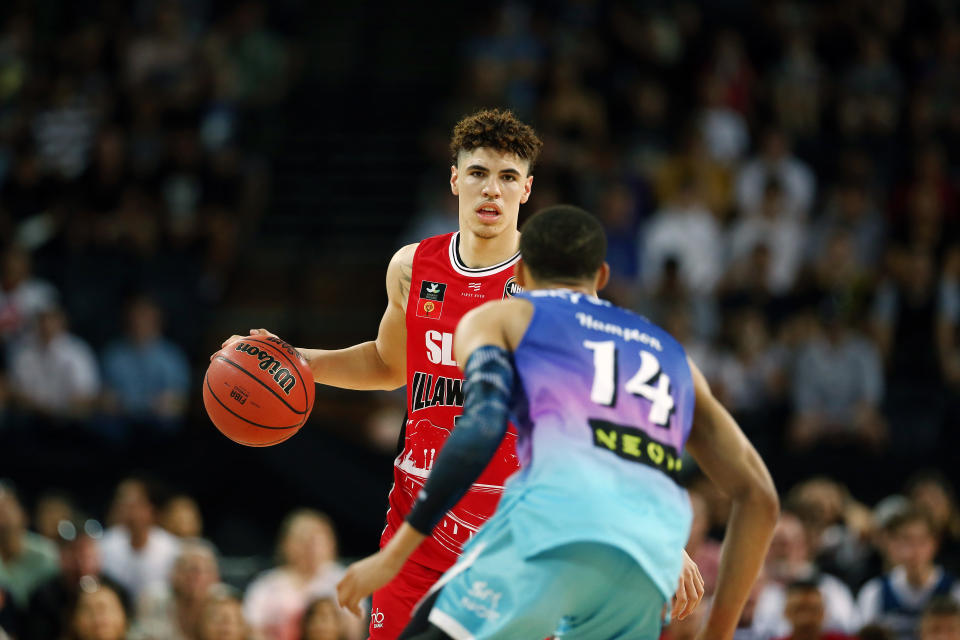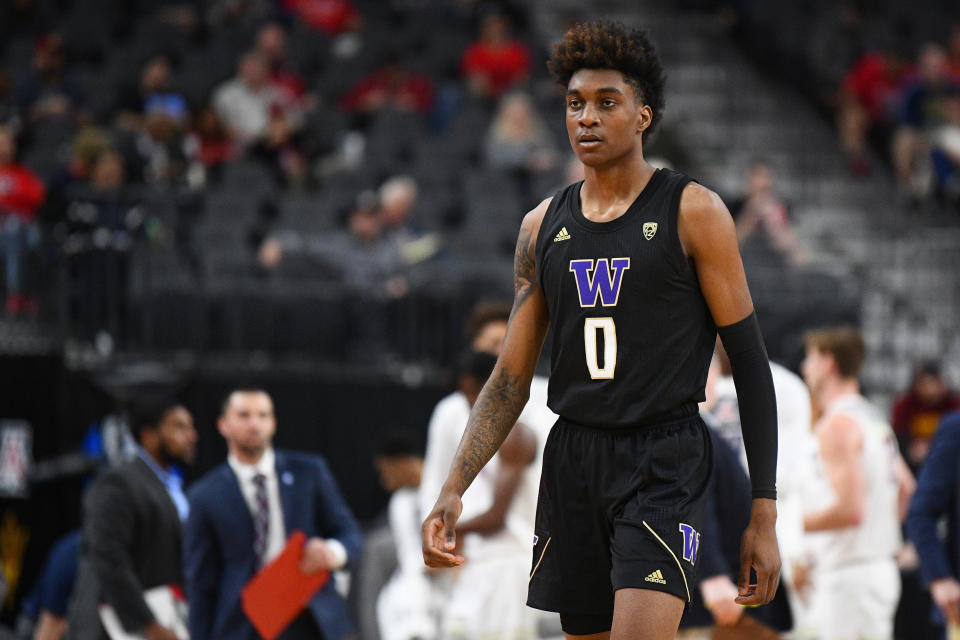With NBA draft date set, LaMelo Ball among five riskiest players with lottery potential
The draft process was put on hold because of the coronavirus pandemic, but now we have a little clarity. The NBA draft lottery will be Aug. 25 and the 2020 draft will be Oct. 15.
The leadup and pre-draft prep still needs to be worked out, but it is a weak draft class, and there are question marks surrounding a handful of players projected to go in the lottery. Here are five potential lottery selections who have high ceilings, yet offer high risks.

PG LaMelo Ball
Ht./Wt.: 6-7, 180
Illawarra (National Basketball League): 17 ppg, 7.5 rpg, 7 apg
Draft range: 1-5
Ball is one of the most intriguing players in this draft. He’s a high-volume shooter with deep range like Trae Young and isn’t afraid to let it fly from all over the court. Like his older brother, Lonzo, his shooting form is a little unorthodox. LaMelo’s release is more in the center of his body with his left elbow flaring out. He only played 12 games in Australia before returning to the U.S. after suffering a minor foot injury. In those 12 games, he made 20 3-pointers but only shot 25 percent from deep. Ball became the first player to record back-to-back triple doubles in the NBL since 2005, but in the second game he took 28 shots to get 25 points and was minus-13 for the game.
There are also concerns on the defensive end. Although he has great length with his 6-foot-10 wingspan, he still gets beat frequently one-on-one and has trouble keeping players in front of him.
Ball doesn’t turn 19 until August and might have the most potential to be a franchise-changing player. Teams can’t overlook the glaring issues of his father’s off-the-court antics and that alone is a risk. Lonzo went No. 2 overall to the Los Angeles Lakers in 2017 and only spent two seasons with L.A. before being traded to the New Orleans Pelicans in the Anthony Davis deal. Will history repeat itself with LaMelo, or will he be a star?

SF Jaden McDaniels
Ht./Wt.: 6-9, 200
Class: Freshman
Washington: 13 ppg, 5.8 rpg
Draft range: 13-16
McDaniels passes the eye test, but he didn’t exactly have an incredible season in his lone year at Washington and he might be the riskiest player in this draft. “There is no other player in this draft with a higher ceiling than Jaden McDaniels, but no one knows if or when he’ll ever reach his full potential and that’s the risk you’re taking,” an NBA scout told Yahoo Sports.
McDaniels was a late bloomer in high school and wasn’t considered a top recruit until the end of his junior year. He chose his hometown school of Washington over Kentucky, and NBA scouts got a chance to see him up close at the McDonald’s All-American Game. McDaniels is built like Kevin Durant with his long 6-foot-9 frame and has all the necessary tools to be a threat on the wing.
Defensively, McDaniels was one of the best shot blockers in the conference, finishing fourth with 43 blocks, and he was a decent rebounder, grabbing 10.6 boards per 100 possessions. Offensively, he struggled, recording 100 turnovers (second in the Pac-12) and only shooting 34 percent from the 3-point line.
His potential lies in his size and versatility, and he could be ideal in mismatch scenarios. He has a high release on his jump shot, and though he only averaged 13 points per game, he did average 23.8 points and shot 40 percent from the field per 100 possessions.
PG Cole Anthony
Ht./Wt.: 6-3, 190
Class: Freshman
North Carolina: 18.5 ppg, 5.7 rpg, 4 apg
Draft range: 8-14
The ball-dominant point guard spent one year at North Carolina and was hit with a wall of obstacles, including a knee injury that sidelined him for six weeks. The team struggled, finishing 14-19, coach Roy Williams’ worst season as a Tar Heel.
There is no question that Anthony can score. He has a great downhill game and is also a fluid passer off the drive. He played 22 games and averaged 18.5 points and was ninth in the ACC in free-throw attempts, getting to the line more than 60 times. His jump shot still needs some work and he struggled from three late in the season.
Anthony doesn’t have much experience playing off the ball, and some teams might hesitate to draft him as a lead guard. His passing is solid, but his runners and floaters in the lane were questionable, falling at a 25 percent clip. There are also teams near his draft range that have established lead guards, so could he play more of a combo guard role? That might be tough. With Anthony being more of a true point guard, some teams early in the lottery might pass on him for a more versatile guard.
PF Precious Achiuwa
Ht./Wt.: 6-9, 225
Class: Freshman
Memphis: 15.8 ppg, 10.8 rpg
Draft range: 8-15
Achiuwa stepped up in a big way once James Wiseman left the team in December and became the top option for coach Penny Hardaway. It’s easy to see why teams would consider taking him in the lottery. He has great size and is extremely athletic.
However, there are some serious questions as to how his game will translate to the NBA. He’s not the greatest shooter and his jump shot does not extend past the 3-point line. In 31 games this season, Achiuwa attempted 40 threes, making 13. He did shoot 50 percent from the field and is a high-volume shooter who sometimes needs 15 or 20 shots to score 20 or more points.
He was one of the best rebounders in the country, grabbing 334 rebounds to lead the conference, and was third in the league in blocks with 58. Achiuwa is most likely a rotational big who will see some solid minutes, but teams in the top 10 might value a guard or a wing because of how the NBA now values shooters and playmakers.
SF Isaac Okoro
Ht./Wt.: 6-6, 225
Class: Freshman
Auburn: 12.9 ppg, 4.4 rpg, 2 apg
Draft range: 4-10
No one got to the rim better than Okoro this past college basketball season. He has a deadly first step on the wing and has a strong downhill game. He plays above the rim and has speed in transition for a player his size. All are very appealing qualities for an NBA wing.
One thing that Okoro is lacking is outside shooting. He shot 51.4 percent from the field but 29 percent from 3-point range. His shot mechanics are inconsistent, and he is easily affected by closeouts or a hand in his face. He also only shot 67 percent from the free-throw line, a surprisingly low number for someone with a decent midrange jumper. Okoro only connected on approximately six field goals per game and only 19.2 percent of those attempts were from beyond five feet.
Teams looking to draft Okoro could be looking two or three years down the road for him to develop. Some consider Okoro’s NBA comp to be Kawhi Leonard, so he is obviously a risk some teams in the top 10 could be willing to take.
Stats are from Synergy Sports and Sports Reference.
More from Yahoo Sports:


